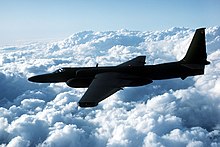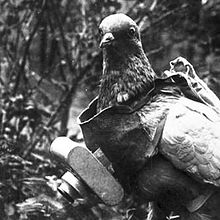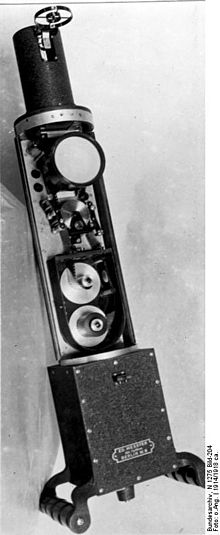Reconnaissance plane
Reconnaissance aircraft are manned military aircraft that are specially built for military reconnaissance . A distinction is made between air-to-ground reconnaissance, as with the Northrop Grumman E-8, and air-to-air reconnaissance, as with the AWACS . Unmanned reconnaissance aircraft are known as reconnaissance drones .
Alternatives are other aircraft such as reconnaissance airships (for example the unmanned Northrop Grumman LEMV ) or reconnaissance satellites . These are primarily used for strategic reconnaissance.
Types of aerial reconnaissance
Tactical reconnaissance

The tactical aerial reconnaissance is carried out for spatially limited, as timely as possible situation communication to the ground forces with aircraft such as the Panavia Tornado or with small or medium-sized drones . Depending on the type, the latter can also be used by the ground troops themselves and enable direct information transfer. Due to the small size, the detection is less likely and a shooting only means loss of material without endangering soldiers.
Strategic reconnaissance
Strategic reconnaissance means gaining fundamental and comprehensive information about the opponent, which gives an overall picture of the opponent's abilities and capacities. Strategic reconnaissance usually takes place over enemy territory or on its border. Either specialized aircraft types (e.g. Lockheed U-2 , Lockheed SR-71 ) or extensively modified types (e.g. Boeing RC-135 ) are used for this. Here, too, unmanned aerial vehicles that have sufficient range and duration of use for this task are used (e.g. Northrop Grumman RQ-4 ).
Procedure
Image reconnaissance
The basic and oldest established form of education consists of taking pictures of the target area. In the days of the balloon , this meant a man with binoculars , paper, and pen making sketches of enemy fortifications. Later, planes took cameras into the air. Up until the 1990s , cameras fitted with superfine black-and-white film were the most important tool in enlightenment, before they were replaced by electronic image capture. Its main advantage is that it can be transmitted in real time . Infrared sensors and radar systems can also provide high-resolution reconnaissance data or images (see infrared photography , radar grammetry ). With large focal lengths and high-quality lenses, spy satellites can take pictures from their orbit with a resolution of less than 30 centimeters from a distance of 250 kilometers.

Reconnaissance aircraft are u. a. the Lockheed U-2 , the Lockheed SR-71 and the Mikoyan-Gurevich MiG-25 RB. These are generally used at a great altitude, which has the advantage of minimal distortion (= optical distortion) at the edges of the image.
IMINT
Imaging intelligence (IMage INTelligence - IMINT) is one of the most important pillars of intelligence gathering and intelligence. IMINT refers to all reconnaissance processes and techniques that provide images of the target area. These can be still images, films or real-time broadcasts.
SIGINT
SIGINT (SIGnal INTelligence = telecommunications and electronic reconnaissance) is a broader and growing area of reconnaissance. Radio signals are tapped ; other electromagnetic signals are recorded and analyzed.
ELINT
ELINT (ELectronic INTelligence = electronic reconnaissance ) is a specialized and very important form of SIGINT reconnaissance. ELINT aircraft are equipped with highly sensitive receivers that can evaluate electromagnetic emissions from the radar defense of a potential enemy. The information obtained in this way is used to develop effective countermeasures. This type of reconnaissance can be carried out from great distances. In a provocative measure, one tries to put the enemy on alert in order to obtain further information, such as the sensitivity and range of the defense network or the reaction times of the interceptors .
COMINT
COMINT (COMmunication INTelligence = telecommunications intelligence) is the interception of foreign radio traffic. Many countries have special COMINT aircraft that record information on all wavelengths for later analysis. Since a large part of the information collected is coded, COMINT teams work closely with cryptanalysts .
TELINT
TELINT (TELemetric INTelligence = telemetry reconnaissance) is a special form of COMINT that records instructions and data transmissions between a missile and ground control during the course of tests. Analysis of this data can provide precise information about the missile's performance.
Radar surveillance
The radar surveillance is not part of the reconnaissance in the strict sense. Radar surveillance is carried out by NATO air forces under the terms AWACS ( A irborne W arning A nd C ontrol S ystem) for air surveillance and STARS ( S urveillance T arget A ttack R adar S ystem) for radar surveillance of ground troops .
technology
The technical equipment ranges from photo cameras to data and radio antennas , microwave receivers to thermal imaging cameras , radar and other devices such as sound recorders, etc.
Tasks, use and risks
tasks
The primary task of military reconnaissance aircraft is to obtain information about the enemy. As described above, different areas are covered depending on the tactical or strategic objective.
commitment
Different types of aircraft are used depending on the task and the optimal technology. These are based on the countermeasures to be expected. Small aircraft such as the Beechcraft RC-12 are suitable for selective reconnaissance measures ; in the case of extensive surveillance without the risk of anti-aircraft measures, high-flying large aircraft such as the Boeing RC-135 are used. In addition to specialized aircraft types, various reconnaissance containers can be mounted on combat aircraft, which, as an external load, enable them to perform the reconnaissance role. There are also modifications and types of aircraft that have been tailored to the role of reconnaissance, e.g. B. McDonnell RF-4 .
Risks
Crews of a reconnaissance aircraft are or were exposed to the dangers of enemy air defense even in peacetime, especially during the Cold War. Up to 150 US Air Force soldiers are missing.
One of the most famous cases is the downing of the U-2 over the Soviet Union and the capture of Gary Powers .
On April 15, 1969, a US Navy EC-121 was shot down by North Korean fighter jets over the Sea of Japan . 31 inmates died.
Again and again civil aircraft were victims of anti-aircraft measures because the alleged reconnaissance victim thought the aircraft was a reconnaissance aircraft and took action. For example with the tragedy of flight KAL 007 : The Soviet air defense assumed it was an ELINT mission over highly sensitive military zones.
history
First World War
The beginnings of reconnaissance flights coincide with the beginnings of aviation. In 1914, double-deckers with one propeller were ready for series production and had become sufficiently safe to use them in the First World War . A German reconnaissance pilot described aerial reconnaissance in the first weeks of World War I as follows:
“My aviation division consists of several aircraft and is assigned to the… army corps. We also do the reconnaissance for this army corps.
In the beginning, the success of air reconnaissance was probably not very much trusted, but was soon taught otherwise. The airport is always a few kilometers behind the battlefield, roughly at the headquarters.
Here at the airport you get your job. You then screw yourself up so that you are about 1200 meters above the enemy. Flying lower is hardly advisable as the French infantry projectile goes quite high.
I already have several holes in the wings. From this height you can observe quite well when the weather is reasonably nice. Our double-deckers are very fast (about 110 kilometers an hour), and so you can scan a very long distance in a very short time. The observer then draws in what he saw and you fly back. From the airfield, the report is then brought to the general command by car. "
At the beginning of the First World War, the Germans used observation balloons. This gave them a tactical advantage in the early fights. A zeppelin was involved in the conquest of Liège (around August 7, 1914) .
The French and British soon used the first reconnaissance planes, which collected valuable information about the enemy positions. The British formed the Royal Flying Corps in 1912 . At the beginning of the war in 1914 it had 84 machines; the French Air Force had 132, the Air Force (Germany) 246.
- Knowledge of the German troop movements behind the front saved the British expeditionary corps a debacle on August 22, 1914 at the Battle of Mons .
- On September 3, 1914, French aviators observed that the German troops under Alexander von Kluck were changing their direction and were now heading for Paris. This led to the decision to launch the counter-offensive on the Marne .
- The British took the first reconnaissance photos of the front on September 15, 1914 over the German lines. Until then, one relied on the statements of the pilots.
With the trench warfare from 1915, comprehensive flight reconnaissance became even more necessary. With the help of the recordings of the enemy lines, exact maps of the trenches on a scale of 1: 10,000 were to be created. This information became more and more important in the course of 1916, especially in the preparations for the Battle of the Somme . From around 1916 both sides were able to produce daily updated maps of the entire front in clear weather.
The photographs also enabled an accurate representation of the relief. Magnifications and ever more precise photo analysis led to better and better results. In 1918, the French army shot and developed tens of thousands of aerial photographs every day.
In France, the SHD (service historique de la Défense) keeps the archives (e.g. 'Archives de l'aéronautique militaire de la Première Guerre mondiale').
In 1935 a flying boat called the Saunders-Roe London was completed. The first version of the London had two Bristol Pegasus III engines of 875 hp each and was designed as a long-range reconnaissance flying boat. Since the series maturity of the following monoplane flying boats in Great Britain was delayed several times, a reinforced version (A.27 London II) came out in 1938. She remained in active service until November 1942 and was then replaced by the Short Sunderland and Consolidated Catalina flying boats, which were then available . Until then, the London II was used in four squadrons of the RAF Coastal Command .
German Empire 1939–1945

At the beginning of May 1939 aerial reconnaissance began with special high-altitude reconnaissance planes over Poland; Wilhelm Canaris and the Abwehr participated in the planning. Special cameras were used for aerial photographs.
The German Reich had several aircraft manufacturing companies , including Heinkel , Dornier and Junkers . In 1933, these three each received a development contract for a twin-engine medium fighter aircraft . Junkers designed the later Ju 86 as a twin-engined low-wing aircraft with retractable landing gear and double vertical tail and received the order to build four prototypes. The Ju 86 G were converted to the JU 86 P high-altitude reconnaissance aircraft in the early 1940s .
The Do 17 was built in large numbers as a long-range reconnaissance aircraft; Dornier designed the Dornier Do 635 in 1944 .
Before the start of the Western campaign , the German Reich apparently used civil scheduled flights to observe the Belgian Fort Eben-Emael . Photos showed a soccer game on the grass on the roof of the fortress; apparently the area was not mined. On May 11, 1940, the day after a German special command with gliders landed there , the defenders of the fort surrendered .
List of aircraft
- MiG-25R Foxbat
- Ilyushin Il-20
- BAe Nimrod R.Mk 1
- Boeing RC-135
- Boeing E-3 AWACS
- Boeing E-8 Joint STARS
- Diamond DA62
- Lockheed U-2 / TR-1
- Lockheed A-12
- Lockheed D-21
- Lockheed SR-71
- Lockheed P-3 Orion (and EP-3 Orion)
- Lockheed ES-3 Shadow
- Grumman E-2 Hawkeye
- Northrop-Grumman RQ-4
See also
- Maritime patrol aircraft
- Fighter plane
- Fighter bomber
- List of aircraft types
- Air war
- Unmanned aerial vehicle
literature
- Regulation H.Dv. 402/1 M.Dv.Nr. 2/1 L.Dv. 2/1, Air Reconnaissance, 1944
Web links
- Spyflight (English)
Individual evidence
- ↑ spiegel.de
- ^ Zeit.de April 25, 1969: Nixon warns North Korea. - Armed reconnaissance after the aircraft was shot down
- ↑ "As a Flieger in Feindesland " in Die Woche , issue 39/1914, p. 1608.
- ↑ a b c www.wegedererinnerung-nordfrankreich.com
- ^ Archives de l'aéronautique militaire de la Première Guerre mondiale ( Memento of July 13, 2012 in the Internet Archive ). Reference to the book of the same name (publisher: Service historique de la Défense), 2008, 570 pages, ISBN 978-2-11-096328-4
- ↑ see also J. Richard Smith, Eddie J. Creek, Peter Petrick: Secret flights: Der Versuchsverband des Oberkommandos der Luftwaffe 1939-1945.
- ↑ Hand chamber Hk 12.5 / 7x9. In: German Spy Museum. Accessed June 2, 2020 (German).
- ↑ www.koelner-luftfahrt.de/ebenemael







